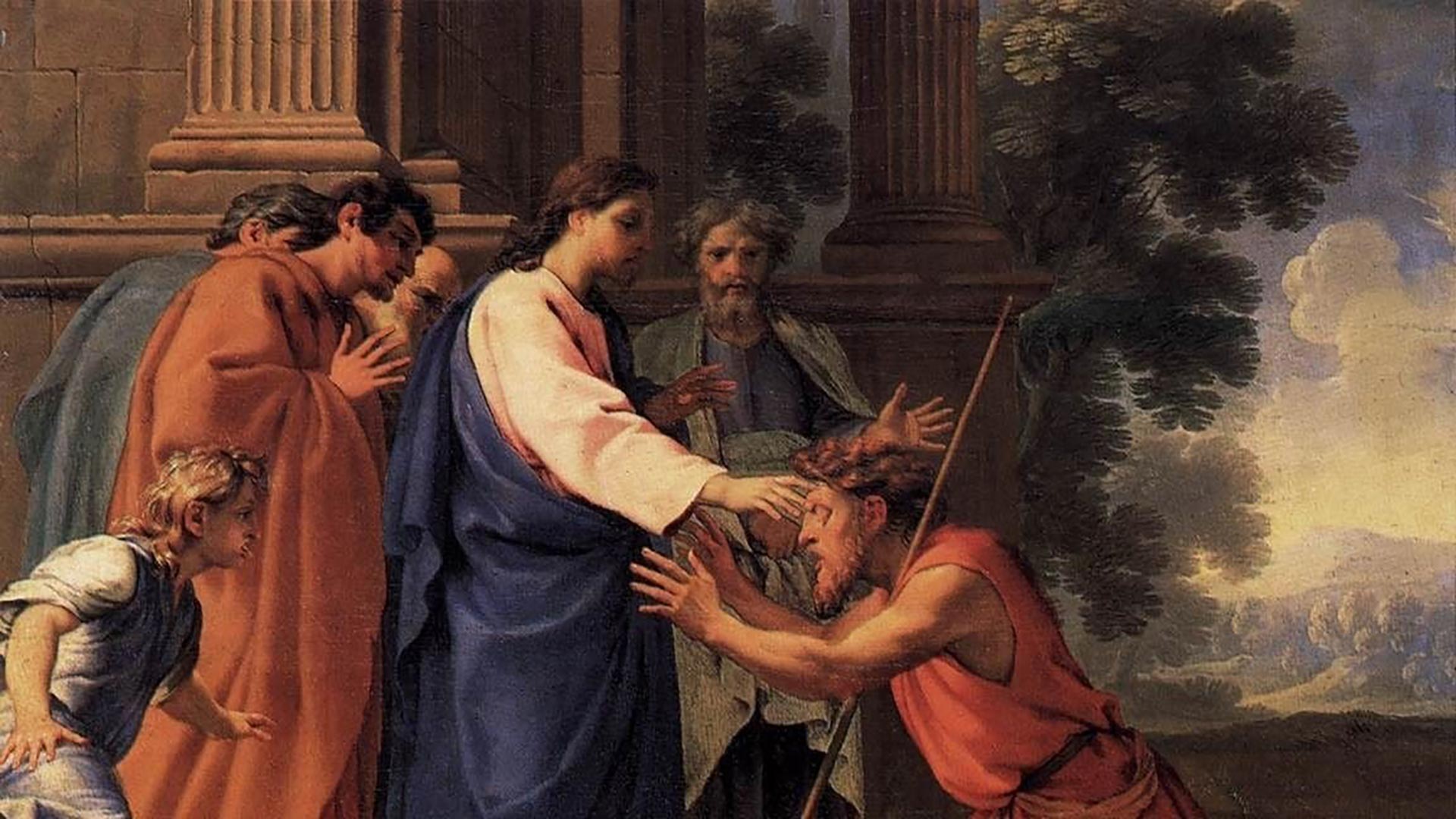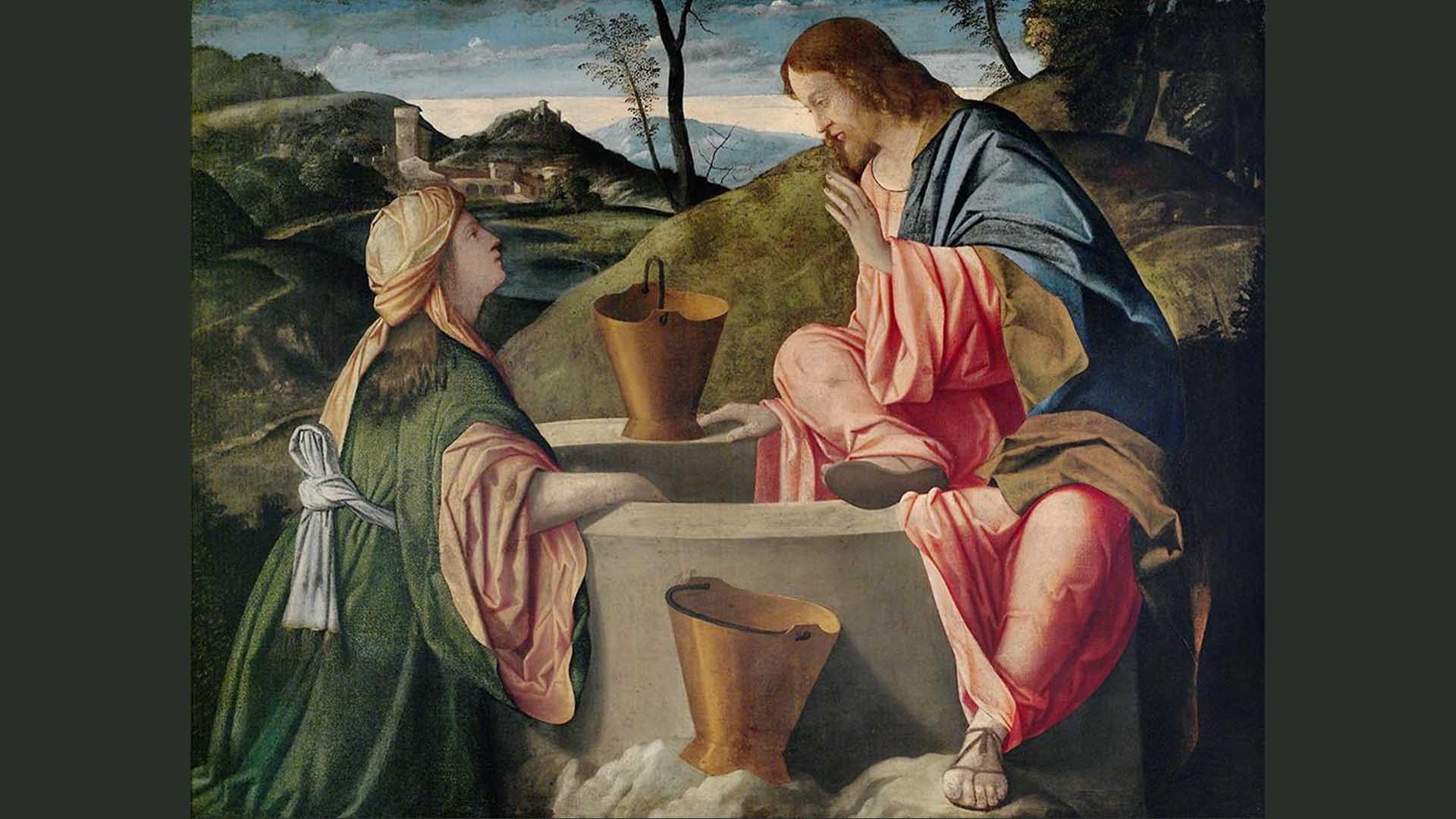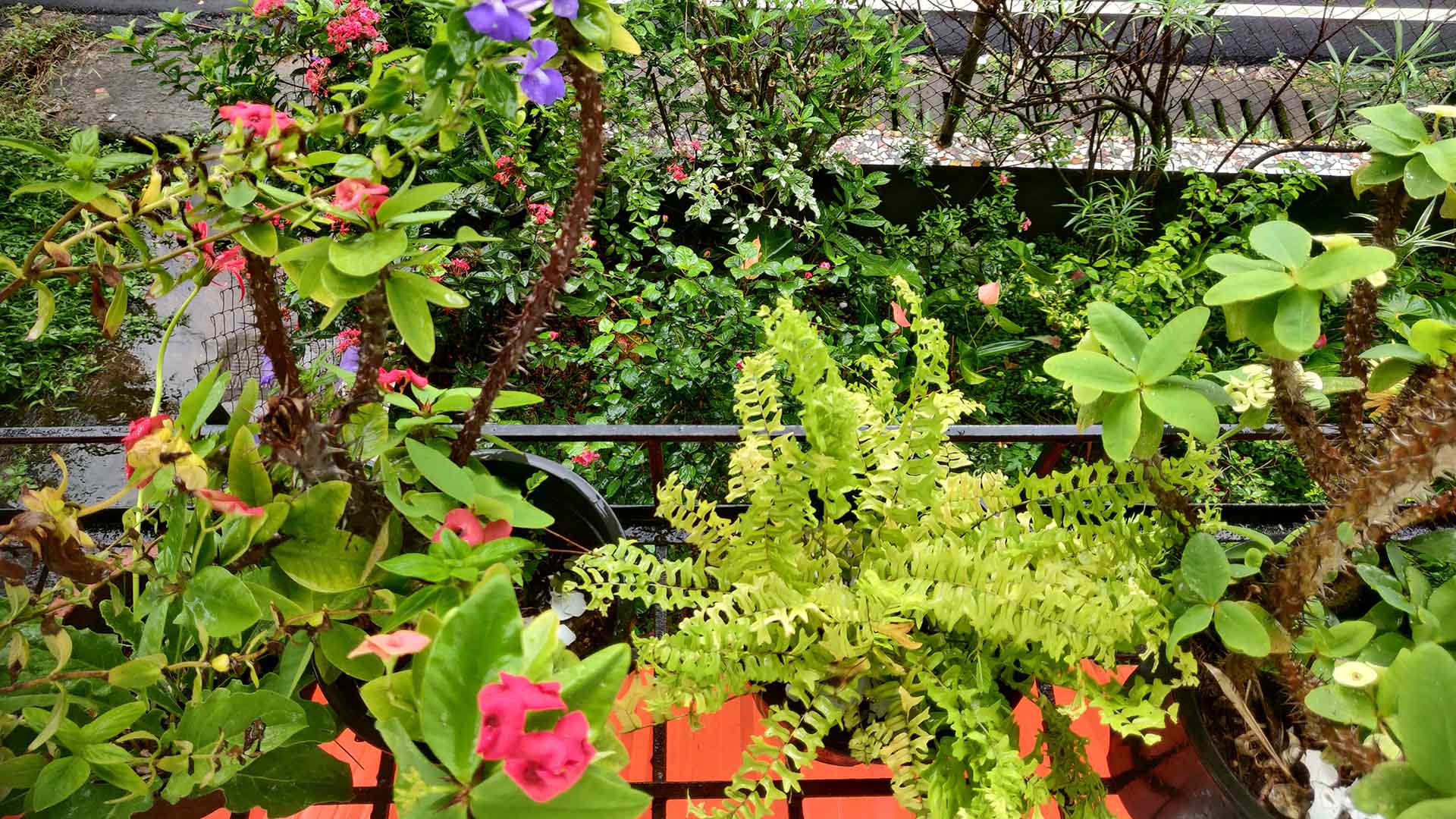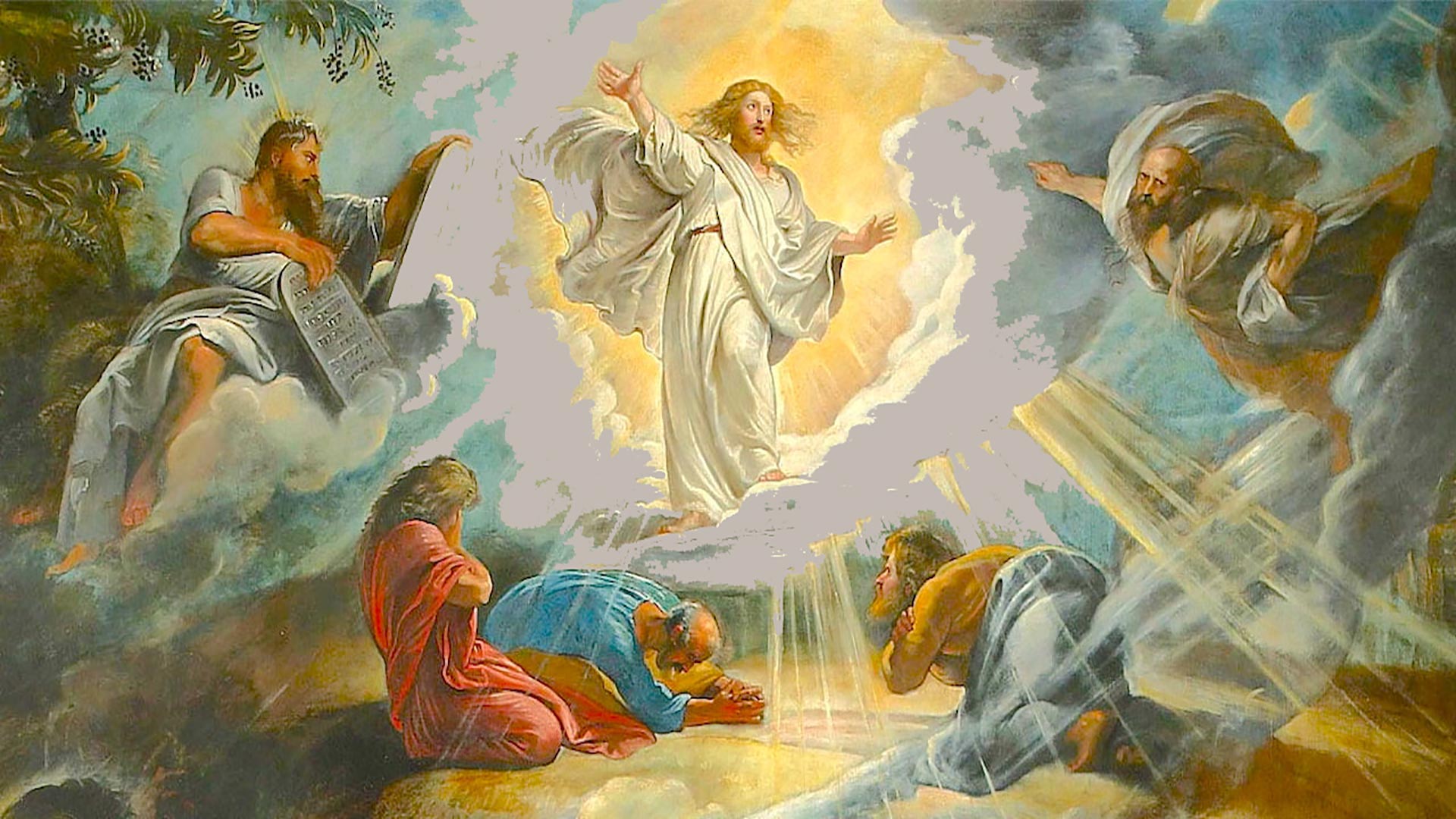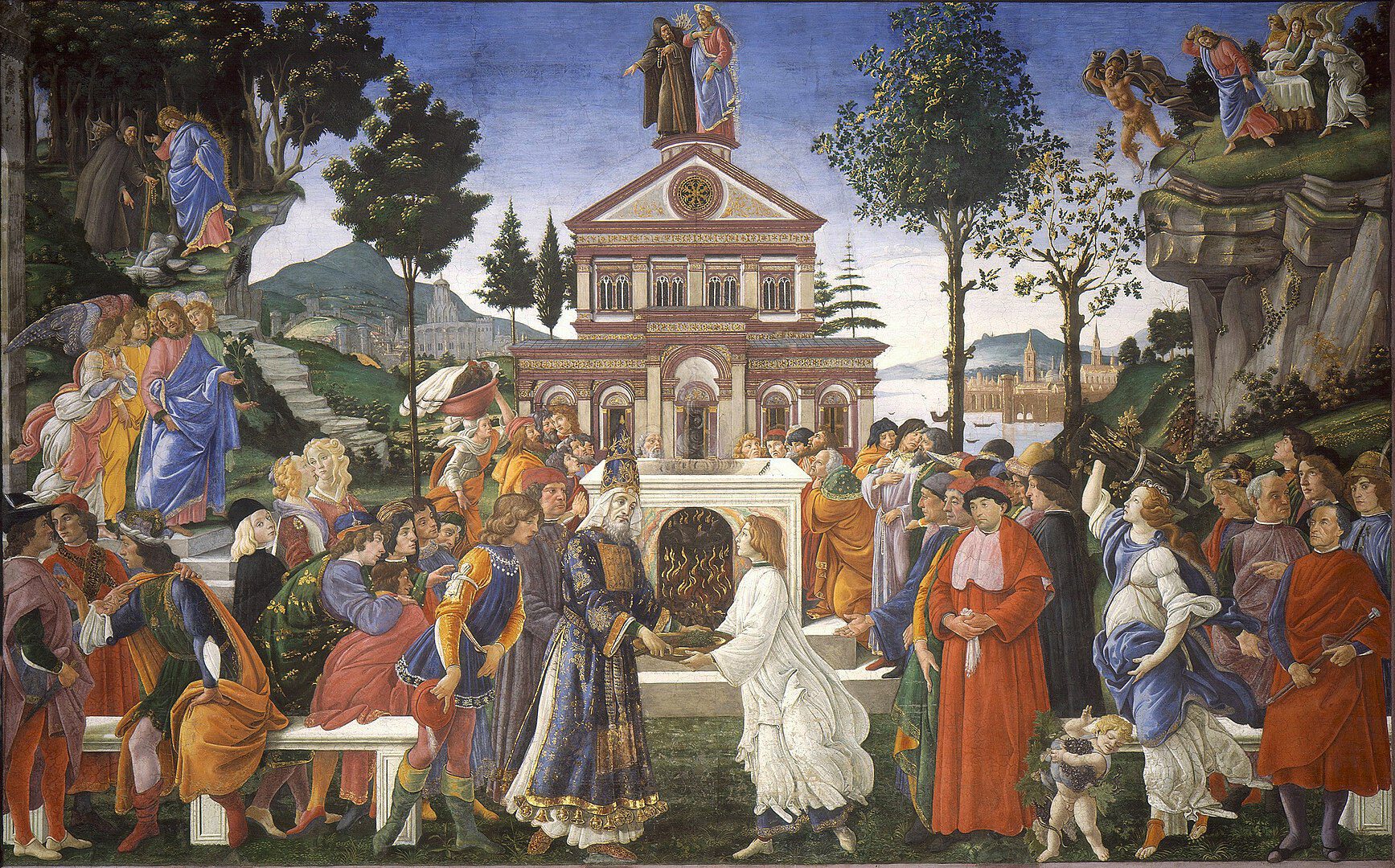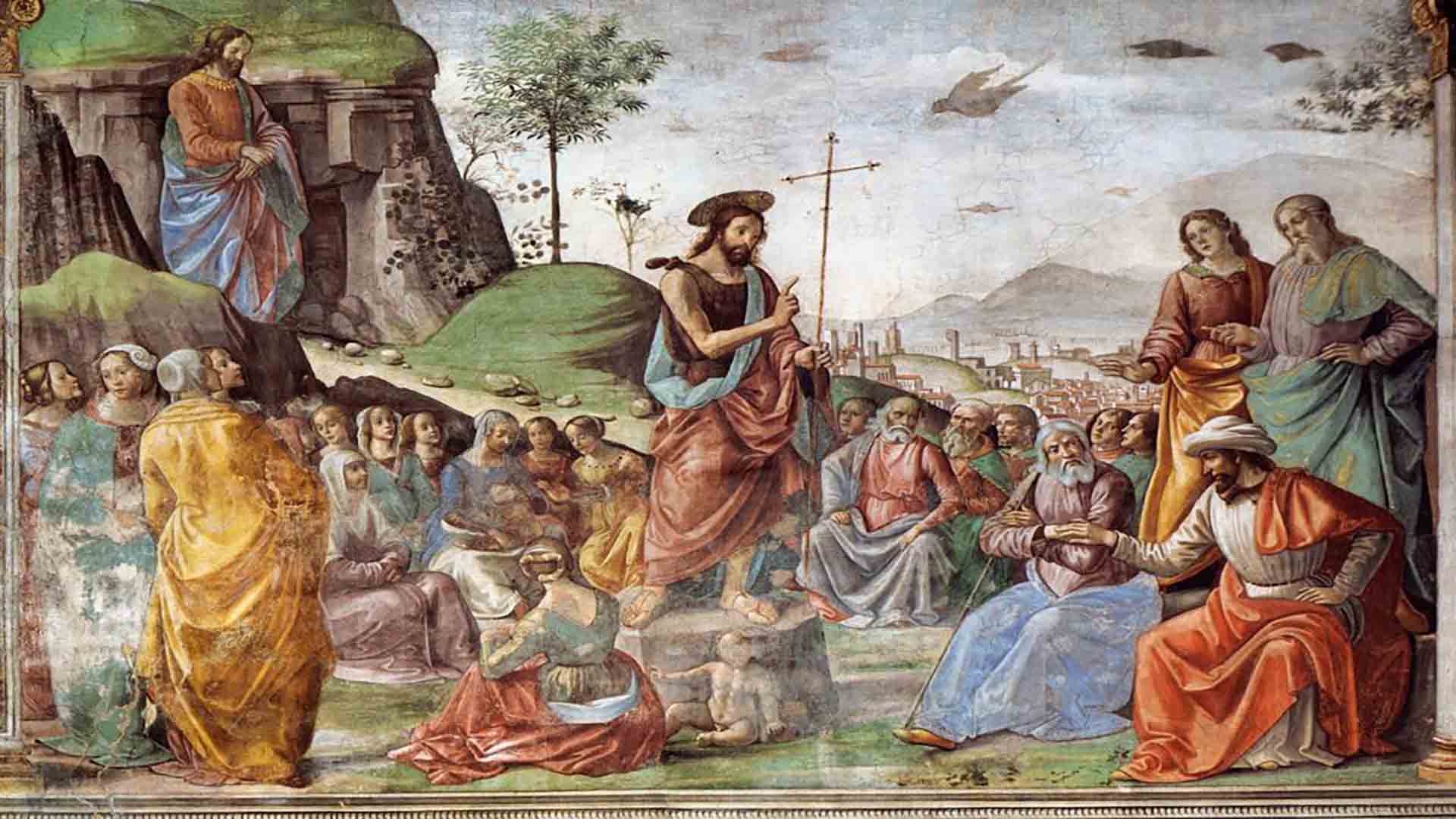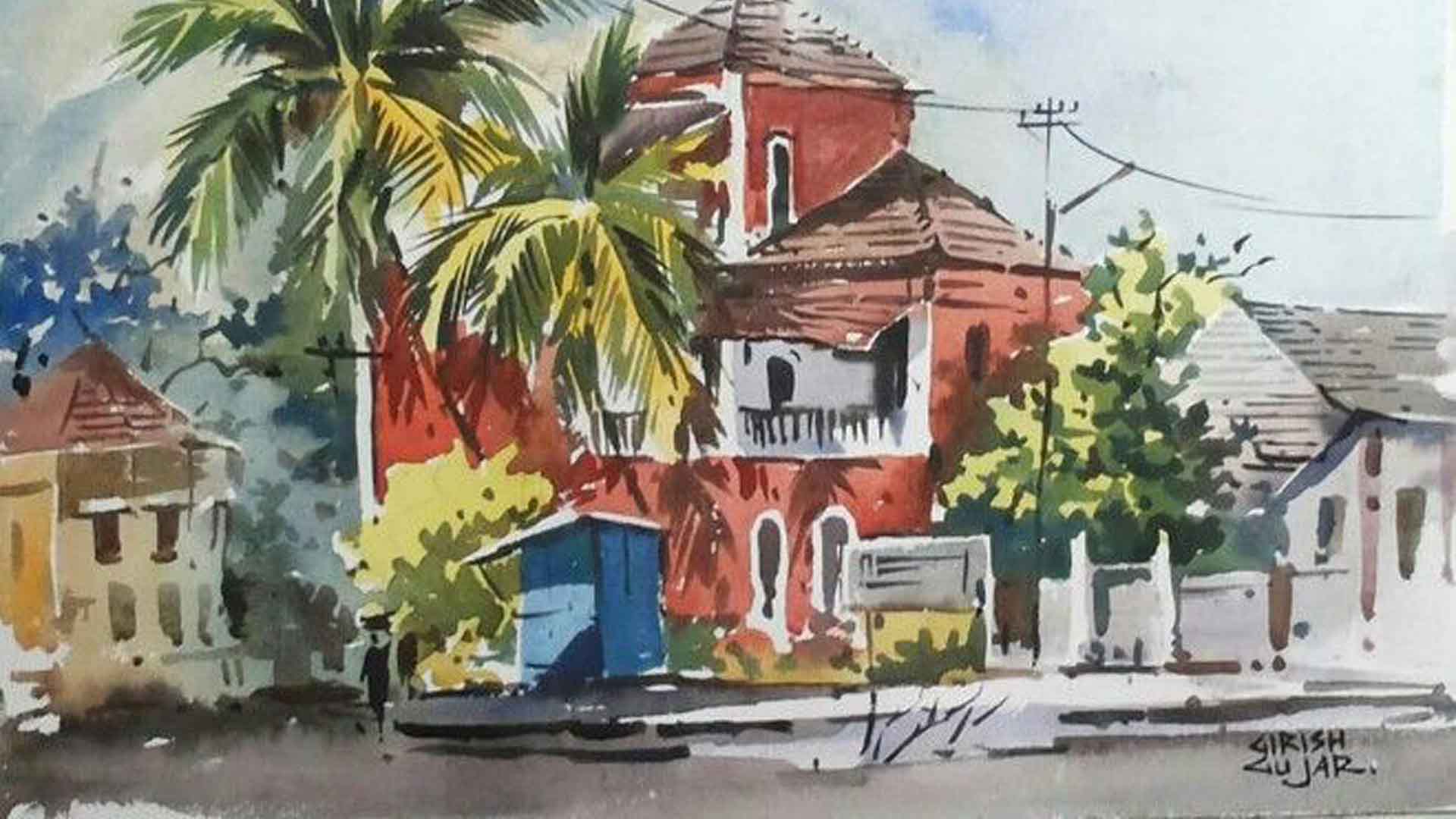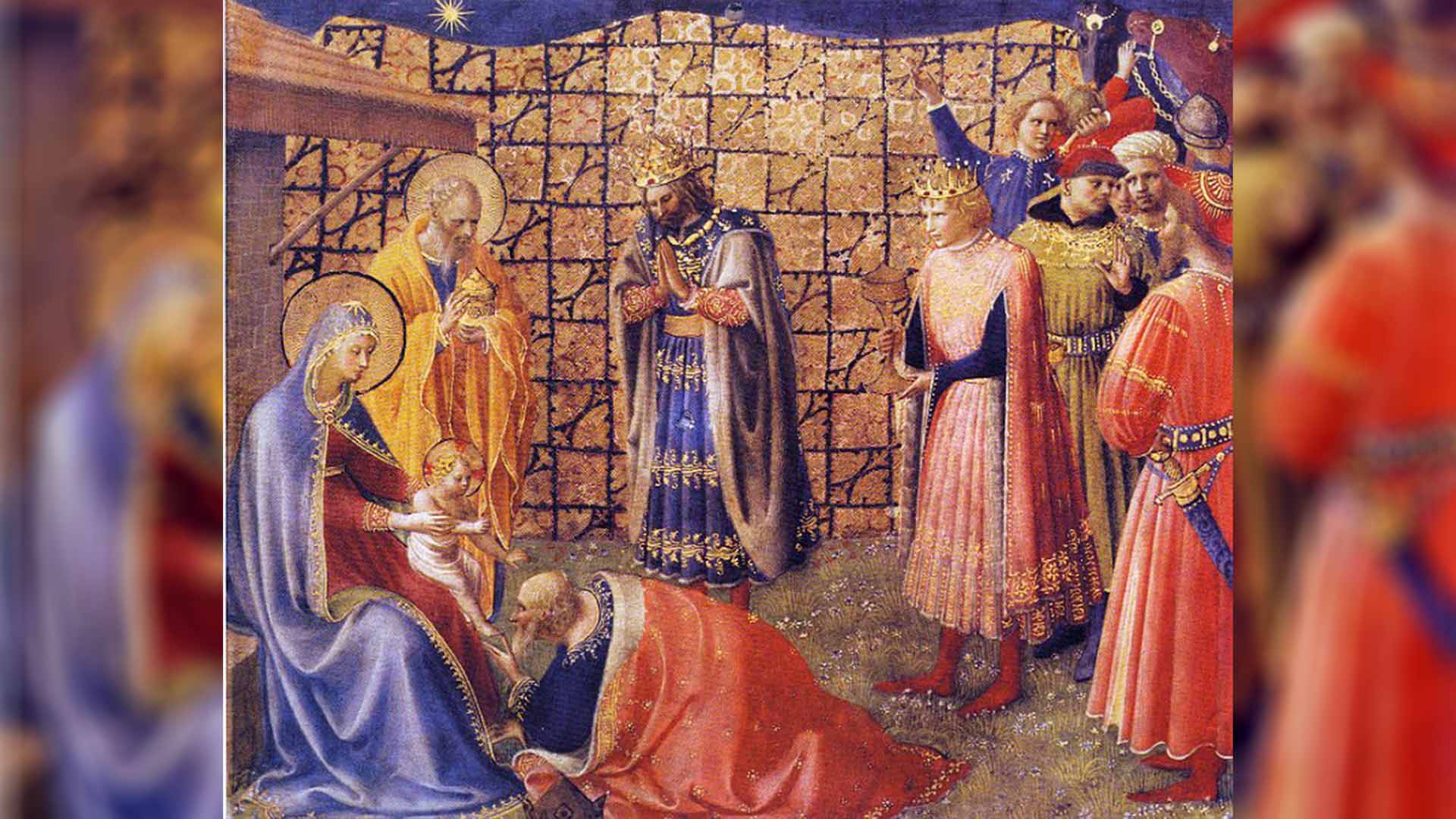The Challenge of the Light
On Laetere Sunday, we are called to joyfully anticipate the victory that will be won and the joy that will be ours at Easter. We are half way through Lent and have progressed by way of prayer, fasting and almsgiving. And particularly through the Liturgy of the Word, we have meditated on the human condition and our response to God’s loving invitation down the ages.
Looking back, on the first Sunday of Lent, the First Reading dwelt on the creation of the world and the sin of our first parents; on the second, the call of Abraham, the father of the people of God; on the third, we read the story of Moses leading his people out of Egypt; and today, the fourth Sunday of Lent, we witness the rise of David (Hebrew for ‘Commander’) as ruler of the united kingdoms of Israel and Judah (1 Sam 16: 1.6-7.10-13). God bid Samuel to anoint the youngest son of Jesse (‘God exists’) with oil, in his hometown Bethlehem.
Thus, David, a shepherd, replaced the first king, Saul, who had disobeyed God, and “the Spirit of the Lord came mightily upon David from that day forward.” Interestingly, a millennium later, Jesus (‘God saves’) was born in Bethlehem (‘House of Bread’) and would eventually declare Himself the Good Shepherd. That city in the hill country of Judah was located about six miles north-west of Nazareth, where Jesus lived until he was thirty, and about five miles south of Jerusalem, where He would die, three years later. Thus ended the public ministry of God’s slain Lamb, so unprecedentedly full of miracles and blessings.
The Gospel of today (Jn 9: 1-41) speaks of one such miracle or "sign": the cure of a blind beggar. Inasmuch as the disciples were bent on knowing if that condition meant a chastisement, they seemed ‘blind’ too. The Master clarified that “it was not that this man had sinned, or his parents, but that the works of God might be made manifest in him.” Proclaiming Himself the “Light of the World”, Jesus sent the blind man to Siloam, which meant ‘The One Sent, the Siloah’. This was incipient baptism, carrying as it did a promise of sweet light and refreshing health to the weak and suffering[1]. Once cured, the man labelled Jesus “a prophet” and later acknowledged Him as the Son of Man. Clearly, he had received not only natural sight but also supernatural light!
Overawed by this occurrence, the local cabal began to work overtime and to close in on Jesus. The Pharisees spread a canard: “This man is not from God, for he does not keep the sabbath.” No doubt, Jesus had cured the blind man on a sabbath but, as elsewhere He had said, “the Sabbath was made for man, not man for the Sabbath. So, the Son of Man is lord even of the Sabbath.” (Mk 2: 23–28) But far from recognising Him as the Messiah, some Pharisees argued that he who has not kept the sabbath cannot be of God. They kept questioning the cured man, in the hope that he would retract his earlier statement, but he retorted: “You do not know where He comes from, and yet He opened my eyes. (…) Never since the world began has it been heard that any one opened the eyes of a man born blind. If this man were not from God, He could do nothing.”
In the face of such irrefutable logic, the only thing left to do was to hype the case against Jesus. The parents were called upon to confirm their son’s congenital blindness; they did, but pleaded ignorance as to the author of the marvel, for “the Jews had already agreed that if anyone should confess Him to be Christ, he was to be put out of the synagogue.” This was pure conspiracy! Alas, how many do the same today! They swim with the current, compromising their principles, that they may gain social acceptance and/or political mileage! Likewise, arm-twisting and intimidation are rampant; it is always the same old story of giving someone a bad name and hanging them!
At that time, Jesus was at the height of his ministry but also at the threshold of his Passion and Death. He was the Light of the World, the light shining in the darkness, but the world did not know Him (cf. Jn 1) The cure of the blind man shows Jesus to be the Messiah, who came into the world “that those who do not see may see, and that those who see may become blind.” That is, His light was “as mighty as to enlighten the lowly as it was to dazzle and blind the proud.”[2] To the Pharisees, who felt targeted by this powerful proclamation, He said that only physical, not spiritual, blindness could be excused.
In today’s topsy-turvy world, one sees right-minded persons banished whereas the doctrinally flawed promoted. But we are not to be frightened or discouraged. By our baptism, we have been invited to cross from darkness to light, from sin to supernatural life. St Paul in the Second Reading (Eph. 5: 8-14) exhorts us to “walk as children of light (for the fruit of light is found in all that is good and right and true), and try to learn what is pleasing to the Lord. Take no part in the unfruitful works of darkness but instead expose them.” Persevering in this mission through life is indeed the challenge of the Light.
[1] Abbé C. Fouard, Jesus Christ the Son of God. Goa: Don Bosco, 1960, p. 290
[2] Op. cit., p. 293
Drinking of the Living Water
Moses almost fell out with God for the sake of the people, and with the people for the sake of God. The dilemma faced by the most important prophet of the Old Testament is palpable: “What shall I do with this people? They are almost ready to stone me!”
It’s lonely at the top if we venture to do things alone! As for Moses, He had God on his side. He more easily saw God face to face and heard Him with his own ears than he could humour the fickle-minded and ungrateful Israelites. Here was a man who had led them out of an oppressive land, across the Red Sea, and into freedom; yet his countrymen pined for the fleshpots of Egypt!
That is what the story of humankind has on the whole been like, as a result of Original Sin. But God never gave up; He knew that doubting pointed to a seeking. He commanded Moses to strike the rock and quench the people’s physical thirst with water in abundance. For their moral guidance He declared the Ten Commandments on Mount Horeb. Yet, one day, there would be a New Moses issuing a new Commandment of Love and from His heart wounded by a lance on Mount Calvary would come forth blood and water.
In the Gospel (Jn 4: 5-42) Jesus offers the Samaritan woman that water of eternal life. At first, mistaking this for the same sparkling water of Jacob’s well that Jesus Himself had asked for, she was confused. But then, with that doubt dispelled, she goes to town, exclaiming, “Come, see a man who told me all that I ever did. Can this be the Christ?” Obviously, open to divine grace, she had welcomed the Word of God.
Meanwhile, Christ’s disciples kept urging Him to eat and satisfy His bodily need; they miserably failed to see the significance of what he had said: “I have food to eat of which you do not know.” What a far cry from the Samaritan, who had understood the Lord. The very perceptive St Augustine sees her therefore as the figure of the Church about to be founded. And the fact that it took a Samaritan woman to proclaim Jesus as that much-awaited Christ shows that none is a prophet in one’s own land, and the Church is destined to attract the whole wide world!
Of the Gospel as a whole, the Bishop of Hippo says: “The things spoken there are great mysteries, and the similitudes of great things; feeding the hungry, and refreshing the weary soul.”[1] Indeed, of great profit are his interpretations of the Lord’s weariness; the sixth hour; the five husbands; the fountain and the well; the living water; the harvest and the labourers, and, of course, of the woman herself.
God promises to reveal to us by degrees the treasures of His love, just as Jesus did to the Samaritan woman. He is the Bread and Water of Life, and woe to us who do not believe it. We, who are heirs to the Holy Scripture and the Apostolic Tradition, must not hang on to new-fangled notions; when we have the Living Bread and Water, of what use is it to pine for the flesh-pots of Egypt? And is it not downright stupid for us who have the Saviour of the World to dabble in a weird world of petty godmen who go about ruining souls?
Let us, then, turn a new leaf. Let us harden not our hearts but rather praise and thank God, bow down in worship and kneel before Him who made us (cf. Ps 94: 2, 6-7). Let us pray for the outpouring of the Holy Spirit into our hearts and be sure, as St Paul teaches in the Second Reading (Rom 5: 1-2, 5-8) that “since we are justified by faith, we have peace with God through our Lord Jesus Christ, through whom we have gained access by faith to this grace in which we stand, and we rejoice in our hope of sharing the glory of God.”
Above all, like the Samaritan woman, let us give witness and proclaim that Jesus is Lord. Pope John Paul has said, “The Church is very much aware of the specific contribution of women in service of the Gospel of hope.” Further, calling on laypeople in general, he states that “[a]s full sharers in the Church's mission in the world, they are called to testify that the Christian faith constitutes the only complete response to the questions which life sets before every individual and every society, and they are able to imbue the world with the values of the Kingdom of God, the promise and guarantee of a hope which does not disappoint.”[2]
[1] St Augustine, Homilies on the Gospel of John, Tractate XV, § 1. https://www.ccel.org/ccel/s/schaff/npnf107/cache/npnf107.pdf
[2] John Paul II, Apostolic Exhortation Ecclesia in Europa (28 June 2003), 41, 42 https://www.vatican.va/content/john-paul-ii/en/apost_exhortations/documents/hf_jp-ii_exh_20030628_ecclesia-in-europa.html#fnref72
Banner: https://www.columbiamuseum.org/collection-highlights/christ-and-samaritan-woman
Goencheo Mhonn'neo - III | Adágios Goeses - III
Damos aqui uma terceira lista de adágios,[1] extraídos do livro Enfiada de Anexins Goeses, obra bilíngue (concani-português), de Roque Bernardo Barreto Miranda (1872-1935).[2] E desta vez, transcrevemos cada um deles também na corrente grafia romana, embora ainda não estandardizada, da língua concani.
Salta logo à vista, na grafia moderna, o desaparecimento dos sinais diacríticos, a saber, os acentos agudo, grave e circunflexo, o til, a cedilha, o apóstrofo e o hífen, que haviam sido introduzidos por influência do português, durante séculos a língua oficial de Goa. Há quem diga que a romanização da escrita causou a eliminação ou deformação dos sons originais do idioma concani.[3] Mas isso, a ser verdade, não teria sido por inépcia do alfabeto romano que, por meio de certas convenções, bem podia dar conta do recado; mas simplesmente por falta de esforços concertados no sentido de padronizar a escrita.[4]
Será que não houve alguma eliminação ou deformação dos sons quando, por compulsões históricas, o concani – escrito originariamente em Goykanadi, alfabeto em desuso há seculos – passara a empregar os alfabetos devanagárico, canarês, malaiala e persa-árabe? Ora, no século XVI, perante esse mare magnum gráfico e a concomitante falta de meios de impressão, o alfabeto romano veio mesmo a calhar, e, ao longo do tempo, ajudou a engrossar a literatura profana e religiosa do concani, língua esta que, por estranho que pareça, havia os que a queriam somente como língua falada[5] e não literária.
Urge notar que perante o papel que a romanização da escrita teve na preservação e promoção da própria língua, é insignificante a alegada eliminação ou deformação dos sons que ela teria causado. Foram os utentes do concani romanizado, na sua esmagadora maioria católicos, que a usaram como língua literária, enquanto outros, por sinal, os hindus, tiveram unicamente o marata como sua língua literária, e só muito mais tarde, ou seja, nos anos sessenta do século XX, vieram a patrocinar o concani; e o fizeram usando caracteres devanagáricos, tal como em marata e hindi, de entre outras línguas indianas.
Em todo caso, deixemos aos peritos determinar se o que modernamente está assente na matéria da fonética e ortografia do concani se acha completamente livre da influência de idiomas dominantes, tais como o inglês e o marata. Aliás, não cremos que exista um sistema de grafia perfeito e igual para todos os tempos; o dinamismo linguístico não o permite.
Passando, em seguida, para o vocabulário dos utentes do concani romanizado: vê-se, no texto ora em consideração, que, sem aferrado purismo, em concani são usados muitos vocábulos portugueses (anjo; festa; padre-vigário; presidente), e vice-versa (betle/bétele; ceira), sendo esse fenómeno osmótico muito próprio de línguas vivas. Assim, longe de se corromperem, ambas as línguas se enriqueceram.
Por sua vez, Barreto Miranda, livre de preconceitos, valorizou não só a sabedoria do povo como também a língua da sua terra natal.
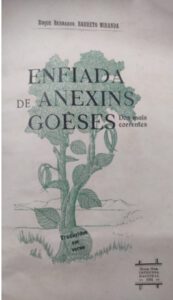
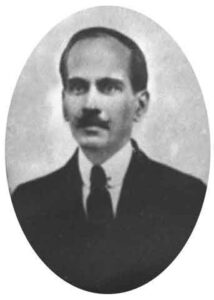
Concani | Tradução literal | Tradução livre
Sarquém anjyachém, cornyô devtçarachyô. | Sarkem anjachem; kornneo devcharacheo.
São de anjo as feições
e de demo as acções.
Uma lindíssima aparência
encobre, às vezes, má essência.
Pann’velichyá nibann moxingak udâk. | Panvelichea niban moxingak udok.
A água com que a betle[6]
(trepadeira) é regada,
apanha-a o moringueiro,
ao qual está enroscada.
P’lo benefício feito aos protegidos,
ficam, às vezes, outros atingidos.
Muy zahunn sakor khavunk zay. | Mui zavun sakhor khavunk zai.
Qual formiga tem de ser,
Quem queira açúcar comer.
Tem que ser, muito pequeno
e humilde, como formiga,
se quer viver bem, sereno.
Fest cortá ganv, Padre-vigarachém nanv. | Fest korta ganv, Padri-vigarachem nanv.
Fest cortá ganv, pirjentichém[7] nanv. | Fest korta ganv, presidentichem nanv.
É freguesia que festeja,
mas quem leva a glória da festa
é padre-vigário da igreja.
Melôlê gayêk bará xér dud. | Melole gaiek bara xer dudh.
A vaca que morreu,
doze ceiras[8] de leite
regularmente deu.
Depois da morte de alguém,
dizem dele sempre o bem.
Vhodd gharak poklé vanché. | Vhodd gharak pokle vanxe.
A casa tem o aspecto apalaçado,
mas ocos são os caibros do telhado.
A casa tem a aparência
de abastança, mas as arcas
não têm a suficiência.
Hatachim canknâm tçouchak arsó zay? | Hatachim kanknnam pollovpak arso zai?
Porventura há precisão
de espelho, para alguém ver
as joias da sua mão?
Não há nenhuma utilidade
servir-se de coisas ou meios,
de que não há necessidade.
Xettiló bôil baynt poddló, ganv ailó | Xettilo boil baint poddlo, ganv ailo
xêtt poddló, konui na ailó. | Xett poddlo, konnui na ailo.
Caiu no poço o boi dum mercador
a aldeia inteira lá compareceu.
Tendo, porém, caído o mercador
ninguém, pessoa alguma, apareceu.
Variante:
Xettitçó bôil mortá zalear, sogló ganv | Xetticho boil morta zalear, soglo ganv
pautá, xêtt melyar konui ye na. | pavta, xett melear konnui ie na.
Se morre um boi dum influente,
toda a aldeia comparece.
mas, em morrendo o influente,
nenhuma pessoa aparece.
Ek taltann taliyô vazâ nãy. | Ek talltan talleo vazonant.
Uma mão só, palmas
não pode bater,
sempre de outra mão,
tem que depender.
Há actos que não podem
ser postos em acção,
sem haver dependência
ou cooperação.
Tus kanddunn hatak fôdd. | Tus kanddun hatak fodd.
Pilando casca de arroz,
nada se adquiriu, senão
as empolas para mão.
De tanto trabalho feito,
não se auferiu proveito.
[1] Cf. Revista da Casa de Goa, Série II, No. 18, Set-Out 2022, pp. 33-34
[2] Roque Bernardo Barreto Miranda, Enfiada de Anexins Goeses, dos mais correntes (Goa: Imprensa Nacional, 1931)
[3] ManoharRai SarDessai, A History of Konkani Literature: from 1500 to 1992 (New Delhi: Sahitya Akademi, 2000), p. 22.
[4] “… representa os sons melhor do que os alfabetos indianos não modificados; e não implica nem com a música nem com os vocábulos.” (Mariano Saldanha, “A Língua Concani: as suas Conferências e a acção portuguesa na sua cultura”, in Boletim do Instituto Vasco da Gama, No. 71, p. 28)
[5] Não é de admitir que se tenha perdido toda a literatura em concani nas fogueiras da Inquisição, pois encontrar-se-ia algo desse registo pelo menos fora da jurisdição desse temido Tribunal.
[6] O mesmo que bétele, planta aromática (Piper betle) cultivada na Ásia.
[7] Corruptela de “presidente”.
[8] Antiga medida de peso, na Índia.
Publicado na Revista da Casa de Goa, Série II, No. 21, Mar-Abr 2023, pp. 59-62
https://acrobat.adobe.com/link/track?uri=urn:aaid:scds:US:a786b796-6b92-390e-a630-270a0648453a
Transfigured by the Cross
After God created man in His image and likeness, He always dialogued with humankind. But alas, the dialogue was soon interrupted by Original Sin; to resume it, God chose Abram, who thus became the first of the Hebrew patriarchs.
Abram, trusting solely in God’s Word, left his hearth and home in Ur, Mesopotamia, and walked into the unknown, to a place later identified as Canaan. The Lord had promised Abram: “I will make of you a great nation, and I will bless you, and make your name great, so that you will be a blessing (…) and by you all the families of the earth will bless themselves.” That is how Abram (meaning ‘God is exalted’) became Abraham (‘Father of many nations’).
The Jewish people are descendants of Isaac, son of Abraham and Sarah, and the genealogy of Jesus is traced to him. But equally pertinent is the fact that Abraham’s near-sacrifice of Isaac foreshadows Jesus’ sacrifice on the Cross. So much for the relevance of today’s First Reading (Gen 12: 1-4) to the season of Lent.
In the Gospel (Mt 17: 1-9) we note that the apostles Peter, James and John had a prevision of the Resurrected Lord. Jesus was “transfigured before them, and His face shone like the sun, and His garments became white as light.” And as though this were not enough, “there appeared before them Moses and Elijah [central Prophets of the Old Testament], talking with Him.”
At that point, Peter, as if to continue savouring the ambience, wished to stay put on Mount Tabor, but he was shaken out of his comfort zone when “a bright cloud overshadowed them, and a voice from the cloud said, ‘This is My beloved Son, with whom I am well pleased; listen to Him.’” The apostles, who were filled with awe, fell on their faces. Jesus bade them to rise and not fear. And just as they had an insight into the Lord’s divinity, even if no inkling into His mission on earth, they also felt emboldened to follow Him.
Their experience was brief but marvellous. Jesus wanted His Apostles to treasure its memory and later testify to its truth, for it would be precisely Peter, James and John who would be destined to witness the Agony in Gethsemani! So, “it was fitting that their faith should be fortified beforehand and their eyes illumined by the effulgence of the Godhead.”[1]
To what extent are you and I fortified – transfigured – by learning of the apostles' experience? Or, do we, like Peter, only wish to feel good and dream of happy days to come? The Transfiguration was – and will always be – a sign that Christ’s mission does not lend itself to trivialisation. Also, we must be conscious of our special mission as Christians, and never feel disheartened or tempted to give up. When we look around us and see people wallow in sin, we ought to see how their happiness is only a mirage.
On the other hand, those who have chosen the narrow part are the fortunate ones, for they are continually transfigured. Jesus had instructed the Apostles to “tell no one the vision, until the Son of Man is raised from the dead.” He indeed rose from the dead; and today, it behoves us to testify with conviction. But St Paul (2 Tim 1: 8-10) says that we have to also “take [our] share of suffering for the Gospel in the power of God who saved us and called us with a holy calling (…) and brought life and immortality to light through the Gospel.”
We can never thank God enough for our holy vocation. Being inheritors of an exalted tradition of faith in action, we are duty-bound to come out and call the world’s bluff. It is high time the world realised that by drawing back from the Cross it is in fact at cross-purposes with God’s loving plan of salvation. For our part, therefore, let us move forward decidedly and be transfigured by the Cross.
Banner: P. P. Ruben’s Transfiguration of Christ
https://www.ecwausa.org/the-transfiguration-of-jesus-in-matthew-17/
[1] Abbé C. Fouard, Jesus Christ the Son of God (Goa: Don Bosco, 1960), p. 263.
From Trials to Triumph
Today’s readings rewind to the creation of the human race and come back to where we stand today. They invite us to renew our faith in Him who sent His Only Son to save the world from the havoc caused by our first parents. The texts are cathartic, to say the least.
The First Reading (Gen 2: 7-9; 3: 1-7) speaks of the Garden of Eden, where it all began. If it wasn’t for Original Sin, the history of humankind would have been different, you may say. But then, why think only of the negative side of the Fall? God, who churns out good from just anything, tweaked it in our favour. Felix culpa, therefore, “O happy fault that earned for us so great, so glorious a Redeemer,” as the Exsultet (Paschal Vigil Mass hymn) chants.
In the Second Reading, St Paul (Rom 5: 12-19) gives a striking description of how “sin came into the world through one man and death through sin, and so death spread to all men because all men sinned.” Further, “if, because of one man’s trespass, death reigned through that one man, much more will those who receive the abundance of grace and the free gift of righteousness reign in life through the one man, Jesus Christ.”
In the Gospel (Mt 4: 1-11), Jesus, the New Adam, reverses the wrong that Adam committed in the Garden of Eden. And behold the spirit and substance of the Son of Man: whereas Adam feasted and fell, Jesus fasted and did not fall. Jesus in the desert represents the new Israel and the new Moses (both of whom spent forty years there) and the new Elijah (forty days). And what a pearl of wisdom He presents when tempted in His human state, by the devil: “Man does not live by bread alone, but by every word that proceeds from the mouth of God”. This has since become the one invigorating thought for when we are tempted by power, knowledge and riches that the world deceptively offers.
Humankind, marked by sin from the very inception, is now at the crossroads. We have taken God for granted; and, missing the point of his goodness, we have taken liberties. Having almost lost the sense of sin we are at a loss to know how to regain our innocence and obtain divine grace. Only to those with a pang of conscience, life feels like a combat, a minute-to-minute battle between the forces of good and evil, grace and sin, God and Satan.
How long can we continue thus? Life is short and unpredictable. Let us be steadfast in God’s love, embrace the Cross and experience God’s mercy. Let us not be disheartened, for if Jesus had to experience umpteen trials and temptations, why won’t we? But then, like Him, we too shall triumph over sin and see the light of the Resurrection.
Banner: Sandro Botticelli's Temptations of Christ, Sistine Chapel (1480-82)
Where are the Fishers of Men?
On the third Sunday in Ordinary Time, Isaiah points to Our Lord as the Light of the World; St Matthew recounts the first days of Christ’s ministry in the wake of St John the Baptist’s arrest; and St Paul exhorts the Corinthians to remain one in mind and heart.
In the First Reading (Is 8: 23 – 9: 3), God in His goodness promises to break “the yoke of [Israel’s] burden, and the staff of his shoulder, the rod of his oppressor”: He would let it triumph over the Assyrians, as He had done against the Midianites, using men armed with clay pots, torches and trumpets!
But even more significant is what Isaiah said about Zebulun and Naphthali[1], both located in Galilee. This region had a large, non-Jewish, immigrant population; hence called “of the Nations”, or “of the Gentiles”. Although the Galileans were thought to be of dubious ancestry, uneducated and seditious, they were in fact more faithful to God than others worshipping false gods. God rewarded Galilee by letting it play host to the Lord of lords and King of kings, who would be a Light to the Nations.
In the Gospel (Mt 4:12-23) we see the realisation of the Isaian prophecy. Bethlehem, where Jesus was born, and Nazareth, where He grew up, were towns in Galilee. It was here that Jesus undertook His three-year ministry. On feeling the heat of John the Baptist’s arrest, Jesus settled in the fishing village of Capernaum, “in the territory of Zebulun and Napthali”. He soon attracted Peter and his brother Andrew, James and his brother John, all humble fishermen, whom he would make “fishers of men”. And “He went about all Galilee, teaching in their synagogues and preaching the gospel of the Kingdom and healing every disease and every infirmity”. He urged them to “Repent, for the kingdom of Heaven is at hand” (Mt 4: 17), thus establishing a link with His Forerunner’s teaching.
But what is “repentance”? And is the kingdom of Heaven still “at hand”? Repentance is a change of mind and heart; it is a flight from sin to God. On the other hand, the hardening of our hearts to God’s call is tantamount to playing into the hands of the devil. “The kingdom of God [or ‘of Heaven’, to the Jews] means, then, the ruling of God in our hearts; it means those principles which separate us off from the kingdom of the world and the devil; it means the benign sway of grace; it means the Church as that Divine institution whereby we may make sure of attaining the spirit of Christ and so win that ultimate kingdom of God where He reigns without end in ‘the holy city, the New Jerusalem, coming down out of heaven from God’ (Rev. 21: 2).”[2]
Thus, Repentance and the Kingdom of God are not passé but vital to our everyday life. They must be uppermost in our minds, especially considering that enemies of the Church are lurking in the shadows. It may come as a shock – but it is a fact – that Rome herself is under siege, and so are you and me. Creditable Vatican observers state that the highest authorities, enchanted by the world, are playing into the hands of the evil one. Such reports are dubbed ‘conspiracy theories’ by those who wish to anaesthetize us but, really speaking, who can deny that idolatry, indoctrination, deception, division, demoralisation, and so on, are the handiwork of the devil? That theological errors abound, moral teaching is being undermined, and tragically, inter-religious ecumenism given the advantage over evangelisation, are signs of the times. If this is not the self-demolition of the Church that Pope Paul VI spoke of half a century ago, what is?
The situation has never been so bad, and it seems like the worst is yet to come. Therefore, what St Paul said to the Corinthians (1 Cor 1: 10-13, 17) is now relevant to a much higher degree: we have to be “united in the same mind and the same judgement”. Whereas in the early days philosophical schools caused discord; in our day and age, Humanism borders on the very denial of God.
On the other hand, in these trying times, where are those “Fishers of Men”? To neutralise nefarious influences, it is of the essence that the powers that be uphold the Apostolic Tradition, that is, “the transmission of the message of Christ, brought about from the very beginnings of Christianity by means of preaching, bearing witness, institutions, worship, and inspired writings. The apostles transmitted all they received from Christ and learned from the Holy Spirit to their successors, the bishops, and through them to all generations until the end of the world.”[3] That is what true Fishers of Men ought to do, Ad Gentes: to the Nations.
[1] Names of two of the twelve sons of Jacob who eventually formed the twelve tribes of Israel; they were brothers of Joseph, whom some of the siblings sold into slavery into Egypt, because they hated him. Only the tribes of Judah and Benjamin survived.
[2] Pope, H. (1910). Kingdom of God. In The Catholic Encyclopedia. New York: Robert Appleton Company. Retrieved January 20, 2023 from New Advent: http://www.newadvent.org/cathen/08646a.htm
[3] https://www.vatican.va/archive/compendium_ccc/documents/archive_2005_compendium-ccc_en.html (Compendium of the Catechism of the Catholic Church, Part One, Chapter two, question 12)
Banner: https://www.wallpaperflare.com/man-standing-on-boat-throwing-net-backlit-dawn-dusk-fisherman-wallpaper-alxue
A Noiva
Vhokol - um conto de Olivinho Gomes traduzido por Óscar de Noronha - A Noiva
As férias judiciais atrasam os trâmites dos processos. Igualmente, o tabelião da comarca fica atarefado com montes de escrituras e doações, a distribuição das diligências e a sua devida passagem para o papel na forma legal deixa o pessoal muito atarefado.
Os tribunais haviam reaberto apenas na véspera. E numa cidade como Margão, onde o meu cartório era o único, estava eu ocupadíssimo, como sempre, quando se deu o incidente que ora vou contar.
Devia ser por volta do meio-dia e meio. Logo em frente ao meu cartório parava um carro do qual saía um cavalheiro jovem e janota. Veio pressuroso até a minha porta e pediu-me licença para falar. Notando esse quê de urgência, disse-lhe que entrasse.
Tendo ouvido tudo o que me contou, vi-me obrigado a interromper o trabalho e acompanhá-lo. Em poucos minutos, contou-me a história de uma senhora, que disse ser sua prima direita. Vivia enclausurada em casa e ora desejava lavrar a declaração da sua última vontade. Como não regulava bem, era necessário cumprir de imediato o seu desejo, de contrário enfurecia-se e era capaz de tudo. Queria ela que eu viesse urgentemente à sua casa.
Fui com Caetano, de carro. A casa situava-se num bairro interior da aldeia da Raia. Levou-nos meia hora a percorrer esse caminho, de voltas e reviravoltas, para chegar ao destino.
Como é que descrevo essa habitação? Não era uma simples casa; era um palacete. Sabe Deus de que século! E parece nunca ter sido tratada. Estava bem nos tempos passados uma construção embrenhada no meio de árvores de teca. Ora, via-se pedaços do reboco de cal caídos no chão, que deixavam expostas as pedras vermelhas. O resto da casa estava às escuras, parecendo prestes a ruir.
Subimos a escadaria meia quebrada e com limos. Caetano gritou por alguém. Apareceu então uma empregada, que trazia na mão uma vela acesa. Com as janelas todas fechadas, era escuro o interior do casarão. Eu, levando a pasta na mão, e com o mínimo de falas, fui pela casa adentro, junto com Caetano, à luz dessa vela.
Caetano arredou a cortina dum compartimento, que não era muito grande; deu-me para passar aí uma rápida vista de olhos. Quando me dei conta da situação, caiu-me o coração aos pés. Nessa casa, toda fechada, ficavam acesas o dia inteiro as velas dos candelabros da parede. Sobre uma mesa lá no canto estavam colocadas umas coisinhas. Aqui e acolá, estavam dispersos frascos de perfume, ganchos de cabelo, pentes, toalhas, lenços, espelhos... e numa cadeira encontrava-se sentada uma senhora, que fitava, murcha, e vestida de branco. Era o traje do seu noivado, que com o tempo se tornara amarelado, desbotado, manchado. Tinha aliás, o seu rosto, crestado pelas rugas, empoado. Calculo que ela não devia passar dos quarenta e tal anos. À sua volta, as aves haviam construído ninhos cobertos com as suas penas.
Apesar de ter entrado no quarto com Caetano, em bicos dos pés, os meus passos causaram-lhe sobressalto. Os seus olhos arredondados, sempre a fitar, mediram-me. Embora parecesse aliviada com a minha chegada, abriu ainda mais os olhos e, de súbito, soltou uma gargalhada danada, e gritou:
- Ha... ha… ha… lá vem o meu noivo. É esse mesmo, esse mesmo. É com ele que me vou casar. Vem ao pé de mim, meu senhor, meu amor. Estou à tua espera, ha… ha… ha...
Cobri-me de suor frio ao ouvir esse riso louco que me eriçou o pelo. Fiquei de alerta. A minha longa experiência de advogado e tabelião público não permitiria que me deixasse levar pela emoção. Ainda assim, senti-me um tanto atrapalhado e com a língua presa.
Procurei acalmar-me, e depois de me recompor, interpus as mãos dela nas minhas, e disse, carinhosamente:
- Não se preocupe, D. Rosa, sou o notário Armando Gomes da Costa. Diga-me, por favor, o que pretende; não se atrapalhe…
Mal ouviu essas palavras, mudou de semblante. Corou, e já não parecendo a mesma, segredou a sua vontade: a de passar as suas propriedades para o nome de Caetano, seu primo direito. Nada disse sobre o porquê e como. Autorizou-me a consultar Caetano. E disse terminantemente que queria que eu lavrasse aí e agora o seu testamento…
Ainda bem. Estava morto por sair da sua presença. E fi-lo juntamente com Caetano.
Sentámo-nos num quarto lá dentro. Na verdade, todos os compartimentos eram lúgubres, porém, este era melhor do que os outros, pois tinha pelo menos uma janela aberta. Logo que nos sentámos, a empregada serviu-nos o almoço e a seguir Caetano contou-me a história da sua prima Rosa.
Rosa Esmeralda das Dores da Silva, filha única, foi alvo do carinho e amor dos seus pais. Era bem-parecida, prendada, inteligente e afectuosa. Aos dezasseis anos de idade, passou no exame de acesso à universidade, seguindo depois para Bombaim para prosseguir os estudos superiores, pois, na altura, não havia colégios universitários em Goa. Era então uma moça que dava nas vistas; não havia rapaz que não se sentisse atraído por ela. Por outro lado, ela não caía por todo e qualquer, nem era de dar muita confiança.
Em Bombaim, matriculou-se no National College, de Bandrá, e fixou moradia na casa de algum conhecido. Em pouco tempo circulava o seu nome pela boca do povo. Era a primeira aluna da turma; como dançarina, não havia igual; e na beleza, era deslumbrante. Muito moço havia estalado os lábios. Como regra, escrevia para casa pelo menos quinzenalmente.
Sucedeu que, após uns sete ou oito meses, uma carta sua entristeceu os pais. Estes, porém, não tinham a coragem de contrariar a filha. Eis o que Rosa lhes escreveu: que viera a conhecer um simpático moço com quem andava enamorada. O rapaz era oriundo do norte da Índia, provavelmente, do Punjabe. As cartas dos seis meses que se seguiram só contavam maravilhas do rapaz: dos bailes a que assistiram, das praias balneares que frequentaram, dos filmes que viram; ao mesmo tempo que pedia novas remessas de dinheiro.
Passado algum tempo, chegava uma carta ainda mais triste. O rapaz, deixando o colégio e a cidade de Bombaim, regressara à sua terra natal, sem a Rosa saber a quantas andava. Numa palavra: ele a havia deixado. Correu ainda que Rosa pretendera suicidar, tendo alguém impedido de o fazer. Foi quando o pai foi buscar a filha de Bombai, e ela passou o ano inteiro em casa. Era manifesta a mudança que sofrera: já não tinha a antiga alegria de viver. Até parecia cansada da vida!
Apesar disso, daí a tempos, com renovado entusiasmo, regressou a Bombaim. Criou novas amizades. Aliás, era esse o seu intuito: travar novas relações, que, na verdade, teve com vários. Parecia-lhe de todo impossível deixar a vida da paródia, a que estava já habituada. Uma vez adquirido um hábito, sobretudo mau, ele torna-se um vício. Mas no meio de toda essa vida desregrada nunca teve sequer um cheirinho da felicidade, pela qual estava sequiosa depois do malogro do seu primeiro amor. Há rapazes que estimulam as emoções femininas, aproveitam-se delas, para no fim as deixar desapontadas. Ser vítima de semelhante infortúnio é o flagelo da moça. Por outro lado, quanto mais ela se defende de tais ciladas, mais cresce a estima e a consideração das pessoas. Mas, no verdor da juventude, poucos se apercebem disso, como também não conseguem discernir entre a paródia ingénua e a maliciosa.
Não deixei que continuasse o sermão.
- Tudo o que diz é pura verdade, senhor Caetano. Mas a mim interessam só os pontos essenciais, ou seja, os passos principais da vida dela. Conte-me só isso, pois quero avançar o testamento. Se não, ela lança-se contra mim…
- Peço desculpa, senhor doutor! Como dizia… é verdade.... – continuou Caetano, retomando o fio da história:
- À Rosa apetecia lançar o barco da vida no alto-mar, sem vela, nem remos, nem leme, ao mesmo tempo que, no meio das águas tumultuosas, procurava ancorar nalgum porto. Por fim, com vista num moço, escreveu a dizer: este é o meu noivo de certeza. Correu que era de Mapuçá; rapaz bem posto, de boas famílias.
O rapaz veio até a Raia para se apresentar aos pais de Rosa. Saiu aprovado. Foi marcado o casamento para daí a um ano, a 15 de janeiro de 1943.
Rosa regressou de Bombaim um mês antes do casamento, tendo completado o bacharelato em letras. Sentia-se tranquila, esperando passar alegremente o resto da vida na companhia do marido. Seria uma vida despreocupada, pois a riqueza da família lhes bastava para mais duas gerações. Importava-lhe apenas deixar o passado e pôr os olhos na construção do futuro. O noivo estava em Bombaim; e, em Goa, talhavam-se as roupas de casamento. Entretanto, o noivo anunciou por carta que chegaria no dia 13, o que deu lugar a dias de grande alegria para todos.
Quando viram que estava iminente o casamento da amimada filha única do batecar, também os manducares do prédio rural deram início a festejos. As suas vojem, dennem e denngui – consoadas – encheram a casa do proprietário. Como o pai da noiva já não pertencia aos vivos, os manducares mais velhos tomaram sobre si os arranjos do casamento, o que facilitou bastante a vida da bhattkan.
Quando o noivo veio à Raia, todo o prédio se encheu de contentamento. Encontrou-se com a noiva, com que acertou tudo: daí a dois dias iam-se casar, sendo a missa às dez da manhã, na igreja da Raia. Assente isso, declarou que seguia a Mapuçá.
Continuaram os preparativos pela noite fora. A manhã do casamento raiou no meio de alegre bulício. Minha prima direita, ora uma bela recatada, que vestira com grande ânimo o seu traje de noiva, estava já pronta. Que linda que ela parecia no seu vestido, bem-talhado e engomado, branco como a neve! Era o seu dia de maior júbilo. E chegou a hora da saída…
Ora, devia faltar um quarto para as dez. Aparecia o carteiro com um telegrama que tomámos como de felicitações. Era para a Rosa. Fui eu a abri-lo e logo ela o arrancou da minha mão. Mal o leu, de acabrunhada pôs-se a dar socos no peito e a chorar aos brados. Estava estonteada; revirou os olhos; começou a tremer; desmaiou, e antes que a segurássemos, caiu ao chão.
O telegrama dizia o seguinte: “Não posso vir ao casamento. Esqueça-me.” O remetente: Eduardo (nome do noivo). Trazia o endereço de Bombaim. E que remédio, se uma traição dessas estava reservada à minha prima direita!
Quando voltou ao siso, Rosa não pôde mostrar a sua linda cara. Estava fora de si. Desde então tem estado encerrada nesse quarto fechado, com a mente também fechada. Mesmo assim, não perdeu a esperança que tinha no seu noivo. Todo e sempre, vestida de mulher prometida em casamento, tem estado à sua espera. Até hoje. Toma banho em dias alternados e traja o mesmo vestido de noiva, e, toda empoada, fica aí sentada a essa mesa e a aguardar a chegada do noivo. De facto, está fora de si. Às vezes, num ímpeto, levanta-se e põe-se a andar; brama ou guincha, fala em voz alta, ou à toa. Só Deus sabe que pensamentos a atormentam! Desse noivo cruel, porém, nunca mais se soube o paradeiro. No meio dessa chocante marcha de eventos, morreu-lhe a mãe, ficando Rosa sozinha, a chorar as mágoas da vida. Dêmos graças a Deus que ela não tenha suicidado, embora a vida lhe tenha sido um lento suicídio.
Com essas palavras, terminava Caetano essa história dramática, que me golpeou o coração. O desgosto da Rosa tornou-se meu também. Ninguém sabe o que pode resultar das nossas acções e quão amargo pode ser o fruto: só de pensar nisso quase que me ia passar despercebida a diligência que ali me havia levado.
Não lhe consegui lançar novamente um olhar. Estava eu a verter lágrimas. Que rapariga modelar, educada num ambiente de alegria, e que ora se encontrava nesse infeliz emaranhado da vida! Haviam-se passado anos e ela envelhecera prematuramente. Não se podia prever a hora em que apagaria essa vela mortiça, deixando a casa às escuras. Por isso, almejava ela reavivar essa vela, o que tornava urgente esse testamento.
Lavrei rapidamente o testamento e com gentileza obtivemos a sua assinatura. E travando a catadupa de lágrimas, com um coração pesado e a mente reflectindo sobre as malhas da vida, saí do sítio o mais depressa possível. Ficou, porém, comigo a imagem triste dessa eterna noiva que nos tempos que já lá vão foi tão bela: ela destroça-me o coração e me persegue eternamente.
Notas Biográficas
Olivinho Gomes (1943-2009) foi concanista de renome, alto funcionário público, e, mais tarde, professor catedrático de concani, na Universidade de Goa. Autor de mais de 40 livros, poeta, contista e tradutor, verteu a Mensagem de Fernando Pessoa e Os Lusíadas de Luís de Camões para a língua concani, respectivamente, sob os títulos de Sondex e Lusiyatonn.
Traduzido do concani e publicado na Revista da Casa de Goa, Serie II, No. 20, Jan-Fev de 2023
Primordial Light
That part of the liturgical year called Ordinary Time (in Latin, Tempus per annum) has begun. It comprises 33-34 weeks outside the major seasons, Advent and Christmastide and Lent and Eastertide. This year, the Solemnity of the Epiphany was the first Sunday, at the head of the first week in Ordinary Time, and Monday marked the Baptism of Our Lord. Historically, Jesus began His public ministry after His Baptism at age 30. So, it is only fitting that the readings of the second Sunday should touch on that primordial light of Christianity.
In the First Reading (Is 49: 3, 5-6), who is that “Servant” chosen to unite the scattered tribes of Israel and to enlighten the world with His Word? The Old Testament refers to several as “servants of the Lord”: Abraham, Isaac, Jacob, Moses, Joshua, Isaiah, Job, Nebuchadnezzar; and even God’s chosen people, Israel, often called 'Jacob'.
While it is no wonder that that title should refer to Israel, eventually it has more specifically come to represent Jesus Christ: “I will give you as a light to the nations, that my salvation may reach to the end of the earth.” Although he was “crushed for our iniquities”, as Isaiah had said (cf. Is 53) that he would be, Christ accomplished His salvific mission. Christianity is the world’s largest and most widespread religion, with over two billion followers representing one-third of the global population. Yet, given that the light of divine revelation is still waiting to envelop the world, there is no room for complacency. Rather, it behoves us to be God’s instruments and say: “Here I am, Lord! I come to do Thy will.”
In fact, it is the vocation of every Christian to walk in Christ’s footsteps and do His will without fear or favour. If God is for us, who can be against us? (Rom 8:31). The Psalm teaches us that He is always by our side, stoops down to us, hears our cry, and turns our cry into song. What is more, He asks not for sacrifice and offerings but for a listening ear and a willing heart. If we only delight in His law from the depth of our hearts – where God’s law is engraved – we will see that He is our only hope and salvation, and proclaim His justice in the great assembly.
In this regard too, St Paul set a noble example to all generations. In a self-introduction to the Corinthians (1: 1-3), he announced that God had called him to be an apostle. He dared to establish a community in a city steeped in corruption, urging sinners to become saints. Thus, the local church of Corinth was symbolic of the universal Church in the making. He warmly encouraged his people to persevere in holiness, for God is holy. What a lesson to be learned by us who so easily get discouraged and begin to falter!
Holiness is a sweet challenge, and only a life of faith, hope and charity can help us attain it. To this end, we must be an alter Christus, ipse Christus – another Christ, Christ Himself! St John the Baptist, who knew the path to salvation, never ceased to say, ‘Prepare ye the way of the Lord’. And although, in his own words, he was unworthy to untie the Lord’s sandals, he baptised Him in the Jordan, “that He might be revealed to Israel”. Curiously, Jesus and John, though relatives, did not know each other closely; one had grown up in Galilee and the other in the Desert. Nonetheless, John instantly saw Jesus was the Messiah, when the Holy Spirit descended and remained on Him, as preannounced to him by the Heavenly Father.
“The Holy Spirit had rested upon Jesus, not only to bear witness outwardly to the grace which abounded within Him, but to exercise an active influence over Him,” says the Abbé Constant Fouard in his classic work La Vie de N.S. Jésus-Christ (1880). “And therefore, so soon as the Christ had received this consecration He was ‘led by the Spirit’, St Matthew recounts; ‘led on into the wilderness,’ says St Luke; ‘sent out’, borne away, driven ‘into the desert’, according to St Mark”[1]. Over there, as is well known, the Son of God came out eminently triumphant from a threefold attack waged by Satan. And however much we may shudder to wonder how God allowed Himself to be tempted by the devil, we should also marvel at how He came out unscathed, “for having taken no part in the perversion of our humanity”[2].
On Jesus’ return from a forty-day stay in the Judean wilderness, where he had prayed and fasted, in close preparation for His public ministry, St John the Baptist saw Jesus coming toward him. It was here that the Precursor presented Jesus as the Lamb of God who takes away the sins of the world, as today’s Gospel passage (Jn 1: 29-34) tells us. To the Jews pursuing John it was evocative of the oracle uttered by Isaiah: “The lamb standing dumb before his shearers, the Man of Sorrows, Who shall bear the sins of the people.” (Is 53: 3) In other words, John was referring to his cousin Jesus, not as a mere symbol of the traditional paschal lamb but as the One who would be immolated on the Cross.
“And I have seen and borne witness that this is the Son of God,” stated the Baptist, very confidently. Should not you and I too respond to the primodial light of our own baptism and bear witness to Jesus Christ, that He may always be “a light to the nations” and His “salvation may reach to the end of the earth”?
[1] Cf. Jesus Christ the Son of God, by Abbé Constant Fouard, translated from the French by George F. X. Griffith; published by Longmans, Green & Co. and reprinted by Don Bosco, Goa, 1960, p. 83.
[2] Op. cit., p. 84.
Choques e Surpresas Culturais | Culture Shocks and Surprises
Editorial*
Enquanto vos saudamos pelo Ano Novo, também vos agradecemos o apoio à Revista da Casa de Goa, que traz novidades, também na presente edição!
Neste número é inaugurada uma secção de Arte, com a colaboração de três residentes de Goa, os primeiros dois oriundos da União Indiana: Payal Kakkar, artista fotográfica, que explora temas desde o património arquitetónico até a paisagem e conservação do meio ambiente; Girish Gujar, aguarelista e professor de arte; e Clarice Vaz, que ora passa a ser nossa colaboradora residente. A todos três, as nossas boas-vindas!
Ao exímio trabalho desses três artistas que focam o legado artístico de Goa juntam-se, sem ter sido este o intuito, dois dos nossos colaboradores regulares, Francisco da Purificação Monteiro, que disserta sobre as igrejas de Diu, as quais apelida de “património esquecido, em grande estado de degradação”; e Mário Viegas, que se refere à casa de um dos mais célebres Deputados às Cortes Portuguesas, Francisco Luís Gomes: “um imóvel quase abandonado”. São como que as últimas novidades da cultura luso-indiana.
Esse estado de coisas leva-nos a questionar a política cultural dos dois países, a Índia e Portugal. Deixemos por ora a gerência interna e falemos do intercâmbio: teriam sido sinceros os Acordos assinados pelas duas partes? Continua a haver a necessária vontade política na execução das multifárias convenções? Porque tanta assincronia a causar choques culturais? É claro que urge repensar as iniciativas oficiais, sendo ainda mais importante atentar ao nosso modo de pensar, e, em particular, aos princípios e opiniões dos nossos intelectuais ou académicos sobre o assunto em apreço.
Nesse sentido, é imprescindível a leitura do ensaio intitulado “Será a cultura GEM vítima de disparate académico?” Philomena e Gilbert Lawrence analisam discursos académicos rivais em relação à cultura colonial de Goa, East India e Mangalore (daí o acrônimo GEM), territórios outrora sob a égide de Portugal. Apontam para autores lusocêntricos, “que glorificam o imperialismo colonial e exageram o impacto colonial positivo no ethos dos nativos”; os indocêntricos, que “demonizaram o imperialismo colonial e exageraram seu impacto negativo nas práticas culturais dos nativos”; e os goanocêntricos, que “têm uma visão mais amena da colonização e descrevem os colonizadores como “benfeitores e pragmáticos”.
Num mundo globalizado em que não é estranho nutrir uma perspectiva mesclada, o livro intitulado Um estranho em Goa, do escritor angolano José Eduardo Agualusa, é objecto de um ensaio de Júlia Serra, que se surpreende com “esse registo cruzado de elementos, provenientes de culturas e histórias diferentes”; e fala de Goa na lusofonia, a qual continua “em reconstrução de uma identidade”, num caminho sem fim.
Temos ainda o ensejo de apreciar mais um ponto de vista sobre a relação luso-goesa, na crónica “Uma passagem por Portugal”, de Radharao Gracias, que, na sua primeira visita ao país nota paralelos com Goa e enaltece as qualidades dos dois povos que mutuamente se enriqueceram. Enquanto Gracias canta um hino ao Pastel de Nata, será que, para sobremesa, também vos ofereço “A Noiva”, um conto em concani, de Olivinho Gomes, em tradução de Óscar de Noronha? Mas, cautela, ficou comigo “a imagem triste dessa eterna noiva que nos tempos que já lá vão foi tão bela: ela destroça-me o coração e me persegue eternamente”.
Se, por um lado, visitantes goeses encantam-se com Portugal, por outro, duas crónicas nesta edição indicam como os emigrantes goeses se comovem quando de visita a Goa. Armand Rodrigues, que do longínquo Canadá visitou a terra dos seus antepassados, descreve um resort único em Goa, o qual tem à testa “um goês que se mudou conscientemente do seu lar adoptivo em Vancouver para a casa ancestral de sua família, transformando-a em um jardim do Éden em miniatura”. Queiram conhecer esse local idílico em Loutulim, aldeia no sul de Goa; e depois, “vagueando pelas terras do Norte”, na companhia de Mário Viegas, conheçam, entre outros locais, Arambol, uma das praias do hipismo, e o histórico Forte de Tiracol.
Na “Rota aérea para o Paraíso”, desfrutamos de uma vista panorâmica de Goa dos anos sessenta: através dos olhos de Ralph de Sousa, testemunhamos o boom do turismo, a chegada dos hippies e de voos fretados vindos da Europa directamente para o aeroporto de Dabolim, no concelho de Mormugão, o qual, diga-se de passagem, com a vinda do novo aeroporto em Mopa, no concelho de Perném, está a viver os seus últimos dias.
Na secção de entrevistas, Ruta Vedpathak Borkar conversa com cinco goeses que estudaram na Universidade de Puna, dantes conhecida como a Oxford do Oriente. E, para terminar, a secção de Notícias fala-nos das actividades do Ekvat, grupo de danças e cantares da Casa de Goa; de um lançamento de livro da autoria de Francisco Xavier Valeriano de Sá, sócio da Casa de Goa; e de “O Clube”, documentário da autoria de Nalini Elvino de Sousa e Pedro Pombo, o qual retrata a vida da diáspora goesa na Tanzânia. Aproveitamos para vos pedir mais informações sobre o que se passa na vossa área de residência ou de trabalho, sobre a temática Goa-Portugal. E continuemos a reflectir sobre os caminhos que poderá vir a percorrer a cultura luso-goesa.
* Texto revisto. Publicado na Revista da Casa de Goa, Serie II, No. 20, Jan-Fev 2023
Editorial*
Let me extend New Year greetings to all you dear readers and thank you wholeheartedly for supporting Revista da Casa de Goa, which comes to you with news and views in yet another edition!
This issue carries an Art section, thanks to the collaboration of three residents of Goa, the first two being settlers here: Payal Kakkar, a photo artist exploring themes ranging from architectural heritage to landscape and environmental conservation; Girish Gujar, watercolourist and art teacher; and Clarice Vaz, who is now a resident contributor. To all three, a hearty welcome!
Unwittingly, these three excellent artists who focus on the artistic legacy of Goa are joined here by two of our regular writers, Francisco da Purificação Monteiro, who writes about the churches of Diu, dubbing them “forgotten heritage, in a great state of degradation”; and Mário Viegas, who refers to the “almost abandoned property” of one of the most famous of the Goan Deputies to the Portuguese Parliament, Francisco Luís Gomes. They are like the latest shocks of Luso-Indian culture.
This state of affairs leads us to wonder about the cultural policy of India and Portugal. Leaving aside their domestic policies for the moment, let us talk about their high-level exchanges: how sincere were they when they signed agreements? Is there still that much-needed political will to implement those varied conventions? Why the asynchrony causing culture shocks? It is imperative to reassess official initiatives, and even more so, pay attention to our rationale, and, in particular, to the principles by which our intellectuals or academics are guided and the opinions they hold on the subject.
In this regard, the essay titled “Is GEM culture a victim of academic baloney?” is vital. Philomena and Gilbert Lawrence analyse rival academic discourses on the colonial culture of Goa, East India and Mangalore (hence the acronym GEM), territories once under the aegis of Portugal. They point to Lusocentric authors, “who glorify colonial imperialism and exaggerate the positive colonial impact on the natives’ ethos; Indocentric authors, who “demonized colonial imperialism and exaggerated its negative impact on the natives’ cultural practices”; and the Goacentric authors, who “have a kinder view of colonization and describe the colonizers as “benefactors and pragmatic”.
In a globalized world where it is not strange to nurture a mixed perspective, the book entitled A Stranger in Goa, by the Angolan writer José Eduardo Agualusa, is the subject of an essay by Júlia Serra. She is surprised by “this cross register of elements, coming from different cultures and histories”; and speaks of Lusophone Goa, now on the endless path of reconstructing its identity.
We also have the opportunity to appreciate another point of view on the Luso-Goan relationship, in “A Passage through Portugal”, by Radharao Gracias. On his very first visit to the country, he notes parallels with Goa and praises the qualities of the two peoples that have mutually enriched each other. While Gracias sings a paean to Pastel de Nata, for dessert may I also offer you “A Noiva”, a short story in Konkani, by Olivinho Gomes, translated into Portuguese by Óscar de Noronha? But, please note, “the sad image of that eternal bride who in times gone by was so beautiful remained with me: she breaks my heart and haunts me eternally”.
If, on the one hand, Goan visitors are enchanted by Portugal, on the other hand, two features in this issue show how Goan emigrants are moved on their visit to Goa. Armand Rodrigues, who from faraway Canada visited the land of his ancestors, describes a unique Goan resort headed by “a Goan who has consciously relocated from his adopted home in Vancouver, back to his ancestral family home, which he has transformed into a miniature garden of Eden.” Please visit this idyllic spot in Loutulim, a village in South Goa; and then, “wandering through the North”, in the company of Mário Viegas, you will get to know, among other places, Arambol, a public bathing beach, and the historic Fort of Tiracol.
In “Skyway to Paradise”, we enjoy a panoramic view of Goa: through the eyes of Ralph de Sousa, we witness “the tourism boom that started in the early sixties, with hippies coming and followed by chartered flights arriving from all over Europe directly to Dabolim airport,” situated in the taluka of Mormugão; which, with the coming of a new airport at Mopa, in Pernem taluka, is now on its last legs.
In our Interview section, Ruta Vedpathak Borkar chats with five Goans who studied at the University of Poona, once known as the “Oxford of the East”. And in the News section we hear about the activities of Ekvat, Casa de Goa’s song and dance group; a book launch by Casa de Goa associate Francisco Xavier Valeriano de Sá; and “O Clube”, a documentary by Nalini Elvino de Sousa and Pedro Pombo, which portrays the life of the Goan diaspora in Tanzania. We take the opportunity to ask you for more information about what is going on in your area of residence or work, focussed on the Goa-Portugal theme. And let us continue to reflect on the paths that Luso-Goan culture could eventually take.
* Revised text. First published in Revista da Casa de Goa, Series II, No. 20, Jan-Feb 2023
Luminous Epiphany
In places where the Solemnity of the Epiphany has been moved from 6 January to the Sunday between 2 and 8 January (both days inclusive), the readings are quite different from those that celebrate it as originally set. Meanwhile, three parishes in the archdiocese of Goa celebrate the feast on the traditional day: the church of Reis Magos (The Magi), in Verem, Tiswadi; the chapel of Our Lady of Remédios (Cures) in Cuelim, Mormugão; and the church of Our Lady of Bethlehem, in Chandor, Salcete; where little boys play the Wise Men who followed a wondrous star to Bethlehem and paid homage to the Infant King.
The Epiphany (from the Greek ‘manifestation’) is a very ancient feast that predates the celebration of Christmas on 25 December. It was central to Christian life: whereas Jesus was born unsung, it was His manifestation to the Magi that illuminated the mystery of Christmas. The early Church combined that Visitation with the Nativity, the Baptism of Christ in the Jordan and the Wedding at Cana, as all those events pointed to Jesus as being the Son of God. Only centuries later, at the Council of Tours in 567, the Church set Christmas day on 25 December, the Epiphany on 6 January,[1] and named the twelve days between the two feasts as the Christmastide, with the latter solemnity marking the grand finale.
The day’s readings highlight an incomparably sublime event in the history of humankind: the manifestation of Jesus Christ. As Isaiah (60: 1-6) looks at battered Jerusalem he envisions it as the quintessential city that will be the Bride of the Lord. The city would manifest its glory, and the peoples of the world would flock to it with gifts, curiously, the same that the Magi would bring to the Babe of Bethlehem centuries later. Most importantly, by the end of times, “all nations shall fall prostrate before you, O Lord,” as sings the Psalm.
While the Gospel passage (Mt 2: 1-12) echoes Isaiah’s prophecy, it also quotes the chief priests and scribes as saying to king Herod that it was indeed written by the prophet (Micah 5: 1-2; 2 Sam 5: 2): “And you, O Bethlehem, in the land of Judah, are by no means least among the rulers of Judah; for from you shall come a ruler who will govern my people Israel.” On the one hand, it shows how well the authorities knew about the coming of a Messiah whom, sadly, they would reject. On the other hand, the reference to Bethlehem is significant, for Jesus would give up on the fortress Jerusalem and choose to be born in humble Bethlehem.
To be noted are Herod’s wily ways: was he not all sweetness who bade the Magi to let him know where the Babe lay, and almost in the same breath ordered the killing of infants under the age of two? A great lesson for us who are naïve vis-à-vis the world and its devious ways. Even while we enjoy the benefits of Christian civilisation, we fail to notice infiltrators bent on paganising the Mystical Body of Christ. Are we, Christians, alert and zealous enough, ready to stand up, speak up? Are we sufficiently imbued with the Good News to desist from entertaining bad news?
We have to emulate the Magi of yore and reject the Herods of the world. Those noble pilgrims from the Orient, astrologers and/or philosophers conversant with Hebraic messianic beliefs, were the first Gentiles to adore Jesus; they accepted Him while the authorities rejected Him – a pathetic drama that is still unfolding in our times. The gifts they offered were gold, in acknowledgement of the royalty of Jesus; frankincense, a reference to His divinity; and myrrh (not mentioned by Isaiah), pointing to the suffering humanity of Jesus.
Finally, St Paul (Eph 3: 2-3, 5-6) states that the Gentiles are indeed “fellow heirs, members of the same body, and partakers of the promise in Christ Jesus through the Gospel.” This is in stark contrast to the narrow and exclusive Jewish idea of Salvation. The chosen race had clearly failed God, so it is now the Church that is that chosen race, royal priesthood and holy nation. It makes you and me privileged bearers and proclaimers of His luminous message. Our task is to put the lamp on a stand, such that it gives light to all in the house! Instaurare omnia in Christo.
Banner: http://www.catholicstpeter.com/Epiphany/slides/adoration__of__the_magi-_fra_angelico.html
[1] The Church has spread out the rest of the feasts. This year, the Baptism of our Lord is celebrated on 9 January.
